Changing the Narrative: A Lesson from the Los Angeles Clippers
2019 is the first year a Canadian team has won the NBA championship, but, as the draft coverage noted, is also 10 years since the Los Angeles Clippers – and their then owner Donald Sterling – drafted their franchise-player-to-be Blake Griffin.
Donald Sterling was, and remains, one of the least popular owners of a sports franchise. Ever. He moved his team from San Diego to Los Angeles without NBA permission, was routinely late paying creditors and fined repeatedly, sued four coaches after firing them (and lost four times), was sued for racial discrimination in apartment tenants (he settled), was sued for sexual harassment twice (one settled, one dismissed), heckled his own players, was rated as the ‘worst owners in sports’ by Forbes and the New York Times and had the lowest winning percentage of any team in the four major sports leagues during his tenure as owner – this despite having a winning record and selling out games for the last 4 years.
None of these, unsurprisingly, was enough for the Association to take meaningful action. The NFL treatment, basically.
His wife, rather than the league, finally forced him out following his recorded racist remarks to his mistress being publicized by TMZ in 2014 (though he fought it bitterly – the legal battle is fascinating in itself). Steve Ballmer, of Microsoft fame, purchased the team for $2 Billion dollars – a record at that time. That the Clippers were worth that amount is an article on its own but ‘the worst team in sports’ was in someone else’s hands.
Fast forward 5 years – the Clippers are a winning, well-run franchise, a leading contender for the NBA Finals’ MVP and have sold out every game played since 2011. Even if Kawhi doesn’t sign – and it appears he won’t – it’s still significant progress.
What can be learned from the transformation?
1) Hires that expect to change the organization
The first thing the Clippers did was probably the largest. Immediately following the transaction’s completion Gillian Zucker was hired as the team’s President of Business Operations. Her predecessor had worked for the team since 1984 and served as President from 2007.
Zucker’s hire showed an intent to shock the system. A well-qualified, experienced (and yes, female) executive in the sports industry laid down a marker for every employee of the franchise – regardless of role – that this Clipper team would be different.
These moves are vital to change culture rather than simply morale. Morale suffers in times of disruption – people afraid of losing jobs, colleagues and status within the organization adds stress. People will jump ship. Success – and recognizing contributions to it – is a huge part of morale and we can’t be afraid of that short-term pain of rehiring talent, rationalizing expenses and rebuilding a new team – of new hires and believers – for the new vision.
2) Show the public a new face – early and often
Zucker’s reputation is largely built on her marketing prowess working to reposition NASCAR races and facilities to a larger demographic. She creatively and bravely sought to reframe the experience entirely in the face of the regional traditional demographic it received. Was it successful? The Clippers needed bravery.

The brand was relaunched in an extremely splashy way – a completely new branding package (there’s a great comparison and description of this here). Hundreds of shirts, hats and merchandise was given away to make a statement of intent that these Clippers shared no history with the years prior.
As much as a public eye can burn a business, changing perception still requires public acceptance. Starting a new product line, and retooling your product offering all require brand recognition for people to connect. Think about Tiger Woods – his self-destruction, humiliation and much-celebrated rebirth all occurred in the public eye. Some will only remember the first two; most will remember all three.
3) Blowing it up can be, and likely is, your best option to rebuild
‘Lob City’ – the nickname given to the last of the Donald Sterling teams – featured three marquee players acquired during the last years of his tenure. Blake Griffin, DeAndre Jordan and Chris Paul represented the best team the Donald Sterling Clippers had ever had despite their underperformance in the playoffs – two trips into the second round of the NBA Playoffs – and were the face of the team upon Ballmer and Zucker’s introduction to the team.
They kept the band together for two years, introduced new talent and large payouts to the team’s big stars – the Clippers still failed. Enter Jerry West – one of the best players and executives the league had seen – and by the end of the 2017 season Griffin, Jordan and Paul, the last remnants of the Sterling era, were gone. Today’s Clippers represent the new regime, with an intelligently managed salary cap, good young team, an exceptional front office, and a premier destination for the NBA’s best.
Congratulations, Clippers. Please though – leave Kawhi in Toronto.

